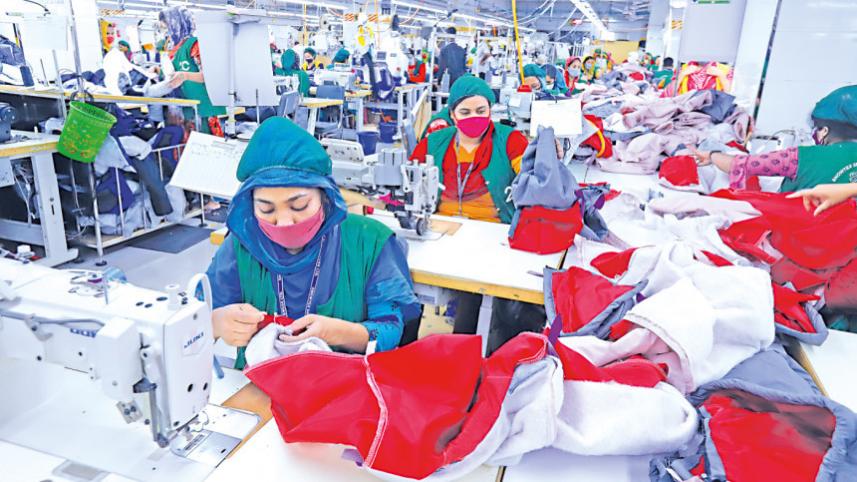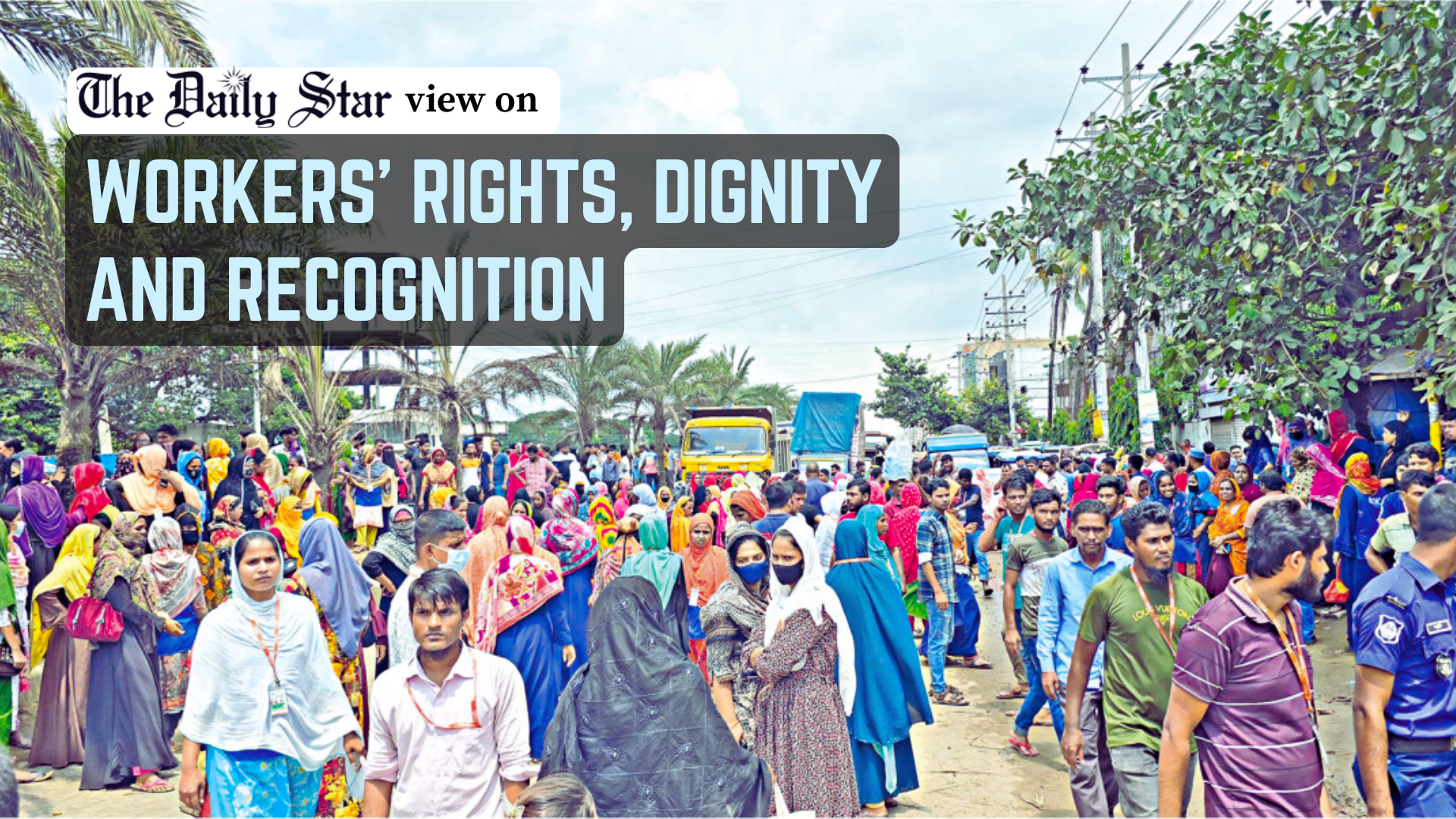Behind our RMG miracle lies exploited labour

Bangladesh's RMG industry is often celebrated as a "miracle," a story of how a low-income country became one of the world's leading apparel exporters. The sector employs over four million workers—80-85 percent of them women. Yet beneath the statistics lies a harsher truth: this miracle rests on exploited labour, suppressed voices, and unpaid value. It is an incomplete miracle because it does not translate into dignity, security, or fairness for those who generate its profits.
The women who form the backbone of the industry carry a double burden. They endure long hours under unsafe conditions and return home to household responsibilities that society rarely shares. Many work six or even seven days a week, often for wages that barely meet subsistence. They have elevated the condition of their families and country, but the system has not lifted their lives. Instead, wage disparity and a persistently low wage share of value added keep them trapped in a cycle of adversity rather than prosperity.
Persistent labour unrest is the clearest symptom of neglect. Workers repeatedly take to the streets to demand higher wages, safer workplaces, and timely payment—often at significant risk, as protests are met with police crackdowns, intimidation, or dismissals. The grievances are familiar: delayed wages, unaffordable housing, lack of childcare, and denial of healthcare. Workplace hygiene remains dismal in too many factories: overcrowding, poor ventilation, unsafe wiring, and inadequate sanitation.
The Rana Plaza collapse in 2013 should have been a turning point, yet safety enforcement remains inconsistent. International buyers demand audits, but these are selectively applied and easily manipulated.
Bangladesh is not unique in facing such challenges, but comparisons show how far it lags. In Vietnam, wages are higher, working conditions better, and labour representation more structured. Trade unions, though restricted, negotiate with some leverage, and the state has invested in dispute resolution mechanisms that reduce violent clashes. Cambodia has made progress under international pressure: minimum wages have risen, and civil society plays a role in monitoring compliance, though constraints remain. India presents a mixed picture. Large export-oriented factories tied to global brands often maintain acceptable standards, but small units remain notorious for abuses. Enforcement varies widely by region. By most measures, Bangladesh trails its peers. Its exports surge, yet its workers remain precarious.
At the heart of the problem lies wage disparity. Economists track this through the wage share of value added—the portion of output that accrues to workers as pay after materials and overhead. In Marxian terms, the surplus value generated by workers far exceeds their wages. Surplus value is the portion of labour left unpaid after costs—wages, materials, and overheads—are deducted. It accrues to factory owners, global brands, and the economy, but not to workers themselves. Rough estimates illustrate the scale: in Bangladesh, workers' minimum wage is set at $110-115 (Tk 12,500) monthly, they generate about $500 in output, and receive a worker's share of approximately 27 percent.
In Vietnam, wages are $250-280 against an output of $600-650, where workers' share approximates to 42 percent. Cambodian workers earn $200-205, generate about $500, and receive a worker's share of approximately 42 percent. In India, wages are $150-180 against an output of $450-500, yielding a workers' share of approximately 35 percent. Bangladesh thus shows one of the widest gaps in surplus value share, even though worker productivity here ranks among the most efficient in the region. The disparity reflects deliberate wage suppression, weak labour rights, and the leverage of global brands that pit countries against each other in a race to the bottom.
Competitiveness is often hailed as an achievement, but it is really a hidden subsidy borne by workers. Export growth is trumpeted, foreign reserves are bolstered, and policymakers hail the sector as the nation's engine of development. Yet the workers who make it possible remain on the margins.
Unlike Vietnam or Cambodia, Bangladesh has not institutionalised meaningful welfare protections. Social security, health insurance, and childcare are minimal or absent. Most factories provide little beyond the legal minimum wage. Welfare programmes are donor-driven, temporary NGO projects, or disaster relief—not systemic rights. Vietnam has gradually integrated workers into social insurance programmes. Cambodia has added allowances for housing and transport. India's larger factories often provide health clinics and maternity benefits. These measures are uneven and imperfect, but they recognise that workers deserve more than survival.
Global brands sourcing from Bangladesh cannot claim innocence. Their relentless push for lower prices drives factory owners to suppress wages and compromise safety. Corporate audits and "social responsibility" pledges are often more public relations than real commitments. Civil society has been crucial in amplifying worker voices. NGOs, journalists, and labour activists have kept the issue alive, forcing occasional reforms. International solidarity campaigns have pressured brands to respond. But these gains remain piecemeal and fragile.
The government must ensure that policy reforms realign incentives so that export success is not built on the backs of exploited labour. This requires raising wages to living standards, protecting freedom of association, and investing in welfare infrastructure. The state's role cannot be that of an enabler of cheap labour.
The story of Bangladesh's garment industry cannot be told only through export earnings, GDP growth, or foreign reserves. It must also be judged by the welfare of its workers. If the foundation is bones broken by labour and hearts broken by neglect, then the miracle is less triumph than mirage. Unless wages and benefits rise to living-wage levels, the garment miracle will remain a story of profits built on adversity rather than shared progress. The question workers ask, "Are we not part of this success?" will decide whether Bangladesh's development is remembered as an inclusive achievement or a collective betrayal.
International benchmarks prove that progress is possible. Vietnam and Cambodia show that wages can rise, welfare programmes can expand, and disputes can be resolved without violence. Bangladesh must catch up urgently. In this information age, the disparity implied by the wage share of value added, where workers' share is only about 27 percent in Bangladesh, is staggering and unsustainable.
The interim government has streamlined airport facilities for expatriates and the diaspora whose remittances sustain domestic household consumption and foreign reserves. Meanwhile, workers in export processing zones (EPZs) enjoy a labour regime that is virtually strike- and lockout-proof. By contrast, the RMG sector remains plagued by low wages, long hours, unsafe and unhygienic conditions, and recurrent unrest. At the core of this neglect lies a gendered reality: 80-85 percent of RMG workers are women. They are the indispensable backbone of the industry, yet remain its most disposable asset—underpaid, under-unionised, and too often silenced by threats from rich and politically powerful factory owners. Bangladesh can continue expanding RMG exports while leaving its workers behind, or it can make necessary reforms so that growth translates into dignity.
Dr Abdullah A Dewan is professor emeritus of economics at Eastern Michigan University in the US, and a former physicist and nuclear engineer of Bangladesh Atomic Energy Commission.
Views expressed in this article are the author's own.
Follow The Daily Star Opinion on Facebook for the latest opinions, commentaries and analyses by experts and professionals. To contribute your article or letter to The Daily Star Opinion, see our guidelines for submission.
 For all latest news, follow The Daily Star's Google News channel.
For all latest news, follow The Daily Star's Google News channel. 

Comments